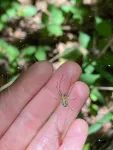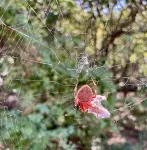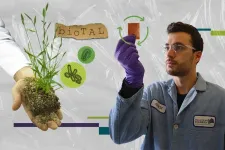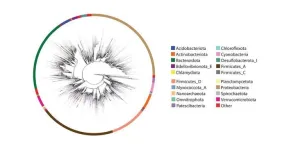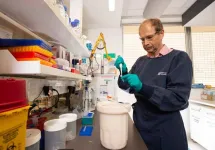(Press-News.org) Spiders are often maligned for being creepy critters, but they are some of the most environmentally friendly pest regulators. Because they actively feed on flies, moths, mosquitoes and roaches, spiders eliminate parasites and many other vectors of disease—protecting both humans and plants from harm.
A new University of Maryland-led study published online in the journal Ecology found one simple way to take advantage of this natural ecosystem service: give tree-dwelling spiders a more diverse habitat.
“We found that there’s a strong link between the species diversity of tree habitats and the population density of the spiders that live in them,” said Karin Burghardt, senior author of the study and assistant professor of entomology at UMD. “Spiders really like complex habitats, so having a large variety of tree species with different structural features like height, canopy cover and foliage density will help increase spider abundance and also the natural pest regulation they provide.”
The study is part of the ‘BiodiversiTREE’ project, a series of large-scale, long-term experiments aimed at restoring diverse coastal forests along compromised shorelines of the Chesapeake Bay. Conducted by the Smithsonian Environmental Research Center and collaborators from institutions like UMD, BiodiversiTree investigates the role of tree species diversity in forest responses to climate change from the molecular to the watershed level.
“There have been some large-scale tree diversity experiments conducted in Europe and Asia, but our study is one of only a handful of experiments of its kind in temperate North America,” Burghardt said. “With this research, we’re discovering crucial information about our local ecosystems, especially regarding how they react to both climate change and restoration efforts.”
The forest plots were planted in 2013 at the Smithsonian Environmental Research Center, where 75 plots of formerly agricultural land were reforested with 16 tree species native to Maryland (including white oak, red maple and black gum trees). Each plot measured 35 square meters and contained 255 trees. On the plots, the researchers planted the same tree species or four or 12 different tree species.
Burghardt’s team began the spider study in 2019. After repeatedly sampling 540 trees in these plots by counting the number of spiders found in each tree, Burghardt and her team found that plots with higher tree species diversity also hosted greater spider populations. By the end of the project in 2021, plots containing four or 12 different tree species supported approximately 23% to 50% more spiders than single species plots, due to their cooler, shadier conditions.
“Plots with more variation in tree species tend to have more canopy cover than plots with only a single tree species,” Burghardt explained. “More canopy cover and tree shade may mean more water retention, cooler temperatures, additional hiding spaces from predators and better web-making environments for spiders—all features that influence spider distribution.”
The researchers found the strongest relationship between tree diversity and spider populations during the late summer months when average temperatures were at their highest. Spider populations in the diverse plots increased more dramatically than those in the single species plots during late August, which could partially be due to spiders’ extreme sensitivity to heat.
“Spider development time and reproduction is strongly influenced by changes in temperature,” Burghardt explained. “In addition, the summer months are also when their prey, insect herbivores, are the most active. This means maintaining certain microclimate conditions is essential to helping to maintain spider population levels and their natural pest control services, which allow managers to minimize the use of toxic chemical pesticides.”
As average temperatures continue to rise due to climate change, populations of tree-feeding insect pests and occurrences of deadly diseases transmitted by pests like mosquitoes and ticks will likely also steadily increase. Designing landscapes that support spiders and other beneficial bugs can offer economically and environmentally sustainable ways to counter this trend. With the results of this study, Burghardt and her team hope to inform stakeholders that land management decisions like tree planting can help keep ecosystems healthy and balanced.
“Overall, the diversity effect seems to be strengthening as our experiment ages,” Burghardt said. “Tree planting initiatives can be used as strategic responses to changes in our local ecosystems, but they can also be proactive maneuvers. Research like this will help us plan more resilient forests for the future.”
###
Other UMD co-authors on the paper include lead author Elizabeth Butz (B.S. ’21, environmental science and policy) and postdoctoral associate Lauren Schmitt.
The research paper, “Positive tree diversity effects on arboreal spider abundance are tied to canopy cover in a forest experiment,” was published online in the scientific journal Ecology.
This research was supported by the National Science Foundation’s (NSF) Division of Environmental Biology (Award Nos. 2044361, 2044406 and 2106014), NSF Research Experiences for Undergraduates (Award Nos.1659668 and 1950656) and the U.S. Department of Agriculture (Award Nos. MD-ENTM-19932 and MD-ENTM-19001). This article does not necessarily reflect the views of these organizations.
END
NDIANAPOLIS—Researchers from Indiana University School of Medicine have diagnosed a Sumatran Orangutan at the Indianapolis Zoo with a rare genetic disease called Alkaptonuria. This is the first time the disease has been confirmed molecularly in a primate other than a human.
The six-year-old orangutan, named Mila, was born at the Indianapolis Zoo in 2016. Mila had a history of dark urine that turned brown upon standing since birth, but has never shown other symptoms. Researchers from the IU School of Medicine Department of Medical ...
University of Missouri researchers are striving to find solutions to the leading cause of maternal mortality in the world — preeclampsia. For Laura Schulz, an associate professor of obstetrics, gynecology and women’s health in the University of Missouri School of Medicine, understanding the root causes of preeclampsia and other complicated, life-threatening maternal conditions is pivotal in advancing women’s health care.
Supported by a renewed $3 million grant from the National Institute of Child Health and Human Development (NICHD), Schulz and her team will use ...
Plastic waste is a problem. Most plastics can’t be recycled, and many use finite, polluting petrochemicals as the basic ingredients. But that’s changing. In a study published today in Nature Sustainability, researchers successfully engineered microbes to make biological alternatives for the starting ingredients in an infinitely recyclable plastic known as poly(diketoenamine), or PDK.
The finding comes from collaboration among experts at three facilities at the Department of Energy’s Lawrence Berkeley National Laboratory (Berkeley Lab): the Molecular Foundry, the Joint BioEnergy Institute ...
Promising new research suggests a total of just 4.5 minutes of vigorous activity that makes you huff and puff during daily tasks could reduce the risk of some cancers by up to 32 percent.
Published in JAMA Oncology and led by the University of Sydney, Australia, the study used data from wearable devices to track the daily activity of over 22,000 ‘non-exercisers’. Researchers then followed the group’s clinical health records for close to seven years to monitor for cancer.
As few as four to five minutes of vigorous intermittent lifestyle physical activity or ‘VILPA’ was associated with a substantially lower cancer risk compared to those who undertook no ...
Johns Hopkins Applied Physics Laboratory (APL) researchers have developed one of the world’s smallest, most intense and fastest refrigeration devices, the wearable thin-film thermoelectric cooler (TFTEC), and teamed with neuroscientists to help amputees perceive a sense of temperature with their phantom limbs. This advancement, one of the first of its kind, enables a useful new capability for a variety of applications, including improved prostheses, haptics for new modalities in augmented reality (AR) and thermally-modulated therapeutics for applications such as pain management. The technology also has a variety ...
Two leading sequencing techniques are no longer at odds, thanks to an international effort led by scientists at University of California San Diego. In a study published July 27, 2023 in Nature Biotechnology, the researchers debuted a new reference database called Greengenes2, which makes it possible to compare and combine microbiome data derived from either 16S ribosomal RNA gene amplicon (16S) or shotgun metagenomics sequencing techniques.
“This is a significant moment in microbiome research, as we’ve effectively rescued over a decade’s worth of 16S data that might have otherwise become obsolete in the modern world ...
There’s no doubt that Aussies love a good celebration. We’re all in when it comes to the weekend, and most of us can’t go past a Christmas celebration without a little bit of overindulging. But all this comes at a cost, and it’s taking a massive toll on our waistline.
Now, a world-first study from the University of South Australia exposes the real weight gains of everyday Australians, in a move to tackle overweight and obesity.
Funded by the NHMRC, and published in JAMA Open Network today, the study explored how weight changes across a 12-month period, finding that weight fluctuated throughout the year.
Specifically, ...
Chemotherapy and radiotherapy aim to destroy cancer cells by inducing DNA double-strand breaks – damage that, once inflicted, usually causes the cells to die. But damage to a cell’s genetic material also activates a signaling pathway called IKK/NF-κB that helps prevent cell death, thus limiting the success of these treatments in patients.
NF-κB is a family of gene regulators that controls a wide variety of cellular processes – from immune responses to embryonic development – and is activated by the enzyme complex ...
Over the last decade, advances in 3D printing have unlocked new possibilities for bioengineers to build heart tissues and structures. Their goals include creating better in vitro platforms for discovering new therapeutics for heart disease, the leading cause of death in the United States, responsible for about one in every five deaths nationally, and using 3D-printed cardiac tissues to evaluate which treatments might work best in individual patients. A more distant aim is to fabricate implantable tissues that can heal or replace faulty or diseased structures inside a patient’s heart.
In a paper published in Nature Materials, researchers ...
QUT researchers have developed a new approach for designing molecular ON-OFF switches based on proteins which can be used in a multitude of biotechnological, biomedical and bioengineering applications.
The research team demonstrated that this novel approach allows them to design and build faster and more accurate diagnostic tests for detecting diseases, monitoring water quality and detecting environmental pollutants.
Professor Kirill Alexandrov, of the QUT School of Biology and Environmental ...
